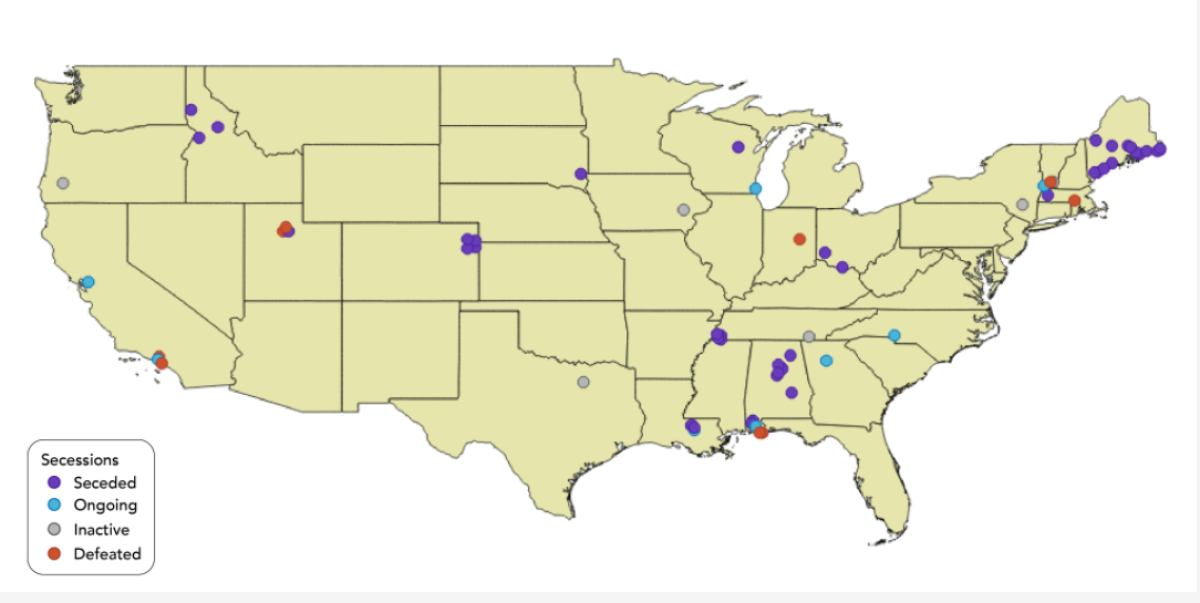
It is no secret that the promise of the 1954 Supreme Court decision in Brown v. Board of Education has never been fully fulfilled. Though that ruling struck down the doctrine of separate-but-equal schooling, it did not provide concrete means to enforce equality or integration. That task fell to lower federal courts, which during the late 1960s and early '70s ordered districts to erase longstanding disparities.
Now, according to a new report by the education not-for-profit EdBuild, those efforts are being reversed around the nation by municipalities seeking "community control" by secession from larger school districts. Those breakaway districts tend to be wealthier and whiter than the ones they leave behind.
The report is titled, "Fractured: The Breakdown of America's School Districts," and it counts 71 secession attempts across the nation since 2000; according to EdBuild, in 47 instances, a breakaway district was formed as a direct result of those efforts. The report counts nine such splinter movements currently taking place across the country.

The report also finds that 30 states have "explicit secession policies" codified in law, but that "only nine require a study of the funding impact of a proposed split," while "[j]ust six require consideration of the effects on racial and socioeconomic diversity and equality of opportunity for groups of students."
As far as the report's authors are concerned, though, there is little doubt that such splintering of school systems is ruinous from both an educational and social perspective. In a strongly worded section, those authors write:
The immediate effect of this kind of segregation on today's classrooms is clear...We have a unique opportunity during children's earliest years to teach them what our country could and should be. There is no doubt that a splintered school system of haves and have-nots today lays the groundwork for a fractured society in the future. We are deluding ourselves if we believe that we can maintain a fair and inclusive culture without putting in the collective effort to support the education of our most vulnerable students—and if we don't unify around that goal, we will surely fail to realize a society in which all children may reach their full potential.
In a phone conversation prior to the release of the the report, EdBuild founder and chief executive Rebecca Sibilia explained that many of the resegregation efforts are rooted in the Supreme Court's 1974 decision in Milliken v. Bradley, which forbade districts from enacting desegregation efforts across school district lines. That vitiated the most powerful, and hence controversial, means of educational equality: school busing.
Sibilia calls Milliken "the single most damaging Supreme Court decision" on educational equity. At the same time, she blames the direct relationship between property taxes and school funding on the desire of many communities to control their schools. If Milliken provides the legal cover, she says, "the way we fund schools creates the incentive."
At the same time, she adds that "you can't fault a community for wanting to provide for their own." We discussed the case of Gardendale, Alabama, a suburb of Birmingham whose attempt to secede from the Jefferson County school district I'd recently covered for Newsweek. The people there were not mean-spirited racists; they simply wanted their own schools, for their own kids. But if Gardendale is to have its own schools—and it will, thanks to a court ruling this spring—that district will be wealthier and whiter than that of Jefferson County.
"You could end up with a community that's unintentionally segregating," Sibilia told me.
"This report helps to highlight where fragmentation is occurring and shows the existing differences in student composition and resources that result from district secession," says Erica Frankenberg, a scholar of school resegregation at Pennsylvania State University. "Because of the meaning that accrues to district boundary lines, my research and that of others suggests that these differences could become more substantial over time. State policymakers should pay particular attention to these findings."
Despite the seemingly grim reality depicted in "Fractured," EdBuild's Sibilia says that some states remain committed to keeping school districts diverse. In part, that involves redistributing property taxes more fairly, while also pushing back against concerns of parents who want local control. No study, after all, has shown that local control benefits students. Integration, on the other hand, helps children of all races. What's often lacking, however, is the will to make good on the elusive promise of Brown.
Uncommon Knowledge
Newsweek is committed to challenging conventional wisdom and finding connections in the search for common ground.
Newsweek is committed to challenging conventional wisdom and finding connections in the search for common ground.
About the writer
Alexander Nazaryan is a senior writer at Newsweek covering national affairs.
To read how Newsweek uses AI as a newsroom tool, Click here.








